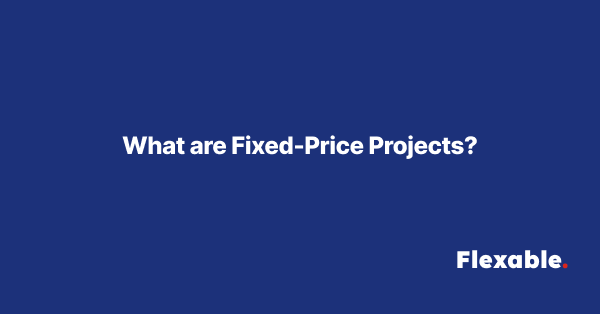In the freelancing industry, one of the most common payment models for projects is the fixed-price arrangement. A fixed-price project is an agreement where the client and freelancer agree on a set fee for the completion of a specific task or project, regardless of the time taken to complete it. Unlike hourly projects, fixed-price projects focus on deliverables rather than time spent, making them an attractive option for clients and freelancers who prefer clear expectations and budgets.
This article provides an in-depth look at fixed-price projects, how they work, their advantages, and their potential challenges for freelancers and clients alike.
What Is a Fixed-Price Project?
A fixed-price project is a type of freelance contract where the total payment is agreed upon upfront for completing a specific scope of work. The price remains constant, and the freelancer is paid upon delivering the agreed-upon results, regardless of how many hours or days it takes to complete the task.
Key Features of Fixed-Price Projects:
- Clear Deliverables: The project scope, timeline, and expected outcomes are defined before the work begins.
- Pre-Defined Budget: The client sets a fixed budget for the entire project, which the freelancer agrees to.
- Payment on Completion: Payment is tied to achieving specific milestones or delivering the final product, rather than tracking hours worked.
Examples of Fixed-Price Projects:
- Designing a company logo for $500.
- Writing a 5,000-word blog post for $1,000.
- Developing a website for $3,000, with separate milestones for design, development, and testing phases.
How Do Fixed-Price Projects Work?
Fixed-price projects follow a structured process to ensure both parties are clear on expectations and deliverables:
1. Scope Definition:
The client outlines the project requirements, deliverables, and deadlines. This may include specifics like the number of revisions allowed, preferred styles, or technical details.
2. Budget Agreement:
The freelancer reviews the project scope and proposes a price. Negotiations may occur to reach an agreement that satisfies both parties.
3. Milestone Creation (Optional):
For larger projects, the payment can be divided into milestones. Each milestone represents a portion of the project, and payment is released incrementally as milestones are completed.
4. Work Execution:
The freelancer completes the work as per the agreed terms, adhering to the timeline and deliverables outlined in the agreement.
5. Review and Approval:
The client reviews the work, requests any revisions (if included in the contract), and approves the final deliverables.
6. Payment Release:
Once the client is satisfied, the freelancer receives the full payment or milestone amount, typically through a freelancing platform or a secure payment method.
Benefits of Fixed-Price Projects
For Clients:
- Budget Control: Clients know the exact cost of the project upfront, helping them manage budgets effectively.
- Predictable Deliverables: Fixed-price projects ensure a clear scope of work, reducing ambiguity.
- No Hour Tracking: Clients don’t need to monitor how many hours a freelancer spends on the project.
For Freelancers:
- Earnings Predictability: Freelancers know how much they’ll earn for a project, regardless of the time it takes to complete.
- Focus on Results: Fixed-price projects encourage freelancers to work efficiently and focus on delivering quality results.
- Reduced Oversight: Unlike hourly projects, freelancers have more flexibility in managing their time without being micromanaged.
Challenges of Fixed-Price Projects
While fixed-price projects offer numerous advantages, they also come with potential challenges:
1. Scope Creep:
Clients may request additional work beyond the original scope without offering extra payment. This can lead to disputes and dissatisfaction.
Solution: Define the scope clearly in the contract and set boundaries for revisions or additional tasks.
2. Underestimating Effort:
Freelancers may miscalculate the time and effort required to complete the project, leading to underpayment for their work.
Solution: Carefully evaluate the project requirements before agreeing on a price, and factor in time for revisions or unforeseen issues.
3. Payment Delays:
Some clients may delay payments, especially if the deliverables are subjective or open to interpretation.
Solution: Use escrow services or milestones to ensure partial payments are made as work progresses.
4. Limited Flexibility:
If the project requirements change significantly, renegotiating the fixed price can be challenging.
Solution: Include a clause in the agreement for additional charges if the scope changes.
When to Choose Fixed-Price Projects
Fixed-price projects work best in the following scenarios:
- Well-Defined Projects: When the deliverables and requirements are clear and unlikely to change.
- Small to Medium-Sized Tasks: For projects with a defined start and end, such as graphic design, content writing, or website creation.
- One-Time Needs: When the client has a one-off requirement that doesn’t involve ongoing collaboration.
When Not to Use Fixed-Price Projects:
- Complex or evolving projects with uncertain requirements.
- Situations where frequent client feedback or revisions are necessary.
Tips for Freelancers Managing Fixed-Price Projects
- Clarify the Scope: Ensure the deliverables, deadlines, and number of revisions are clearly defined in the contract.
- Break Down Large Projects: Use milestones for large projects to secure incremental payments and track progress.
- Price Strategically: Calculate your rate based on the project’s complexity, expected time, and value to the client.
- Request Escrow Payments: Use freelancing platforms that offer escrow services to ensure payment security.
- Set Revision Limits: Define the number of revisions included in the price to avoid excessive rework.
Conclusion
Fixed-price projects are a popular payment model in freelancing, offering predictability and clarity for both freelancers and clients. By focusing on results rather than hours worked, these projects create a structured approach to collaboration that benefits all parties.
However, fixed-price projects require careful planning and clear communication to avoid challenges like scope creep or underestimation of effort. When managed effectively, fixed-price projects can lead to successful collaborations, satisfied clients, and reliable earnings for freelancers.
Whether you’re a freelancer or a client, understanding the dynamics of fixed-price projects is key to achieving a smooth and productive working relationship.

